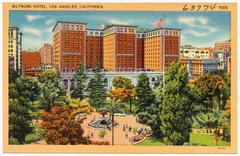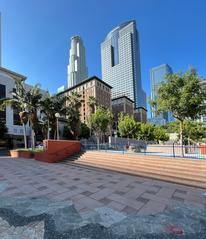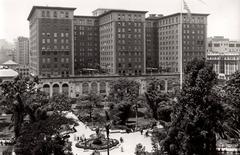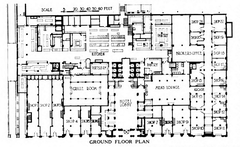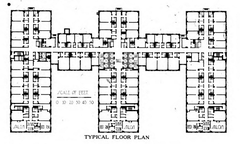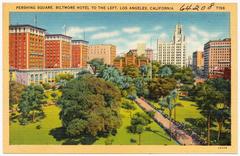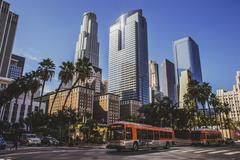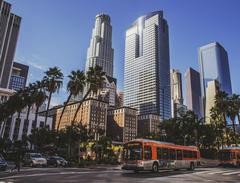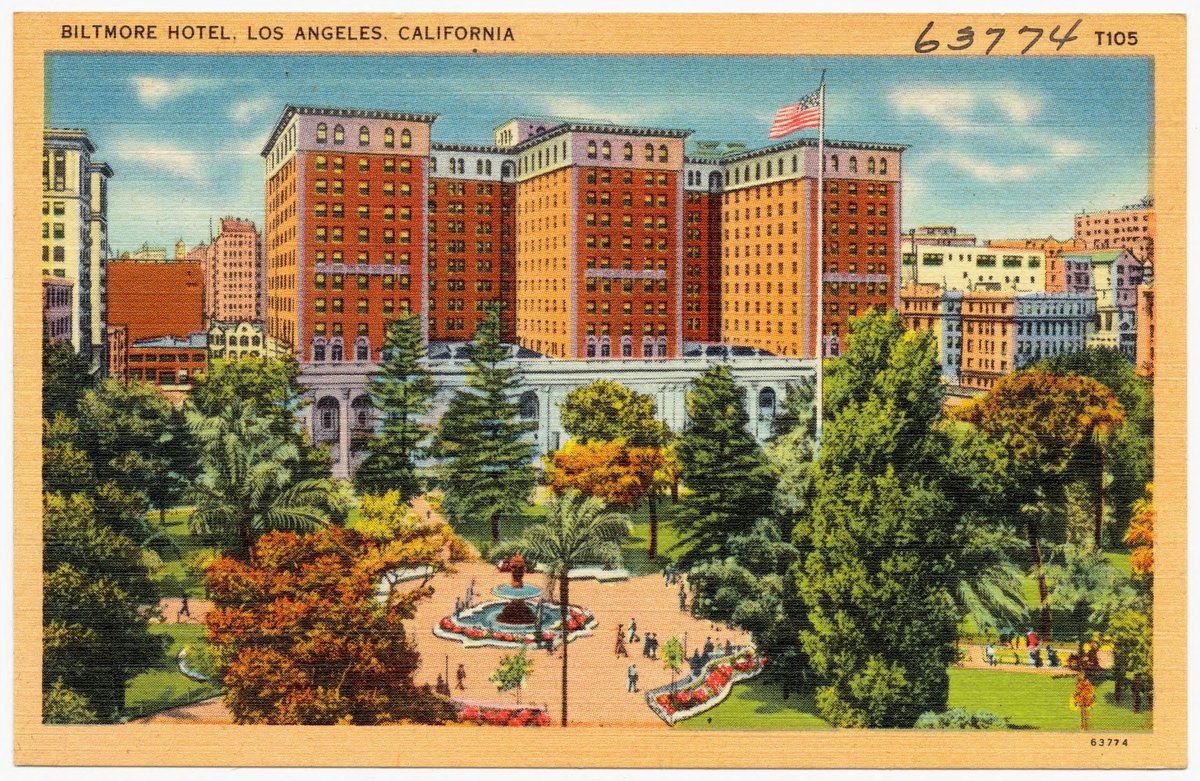
Millennium Biltmore Hotel Los Angeles: Visiting Hours, Tickets, and Historical Significance
Date: 14/06/2025
Introduction
Nestled in the heart of downtown Los Angeles, the Millennium Biltmore Hotel is a striking symbol of the city’s rich cultural heritage and architectural grandeur. Since opening in 1923, the Biltmore has evolved from a luxury accommodation into an iconic landmark celebrated by architecture enthusiasts, historians, and Hollywood aficionados. Designed by Schultze & Weaver—architects of New York’s Waldorf Astoria—the Biltmore combines Beaux-Arts grandeur with Spanish-Italian Renaissance Revival influences, reflecting the Mediterranean aspirations of early 20th-century Los Angeles (Western Art & Architecture).
From hosting multiple Academy Awards ceremonies to serving as the conceptual birthplace of the Oscars within its Crystal Ballroom (Academy Museum), the Biltmore is woven deeply into the fabric of Hollywood’s golden era. Its halls have welcomed presidents, celebrities, and dignitaries, notably serving as headquarters for the 1960 Democratic National Convention (Millennium Hotels). With tales of Prohibition-era revelry, ghost stories linked to the infamous Black Dahlia case (LA Ghost Tour), and meticulously restored public spaces, the Biltmore remains a living testament to Los Angeles’ past and present.
This guide provides detailed information on visiting hours, tickets, accessibility, and tips for making the most of your experience at one of LA’s most celebrated historical sites (Millennium Hotels; Discover Los Angeles).
Table of Contents
- Introduction
- Origins and Construction
- Architectural Significance
- Hollywood Connections and Cultural Legacy
- Political and Social Milestones
- Decline, Preservation, and Restoration
- Legends, Lore, and Haunted History
- Visitor Information
- Dining and Amenities
- Practical Visiting Tips
- Frequently Asked Questions (FAQ)
- Visuals and Media
- Conclusion
- References
Origins and Construction
Conceived in the early 1920s, the Millennium Biltmore Hotel was intended as a symbol of Los Angeles’ emergence as a major American metropolis. Construction began in 1921, led by Schultze & Weaver, with a staggering $10 million budget. The hotel officially opened on October 2, 1923, with a lavish gala that welcomed more than 3,000 guests (Untapped Cities).
Architectural Significance
Style and Influences
The Biltmore is a masterwork of early 20th-century American architecture, blending Beaux-Arts symmetry and monumental scale with Spanish-Italian Renaissance Revival motifs. The design draws on Los Angeles’ multicultural heritage, featuring travertine walls, Mediterranean murals, and ornate carvings. Notable artist Giovanni Battista Smeraldi, famed for his work at the White House and Vatican, painted the hotel’s 24-karat gold-accented ceilings (Millennium Hotels).
Key Exterior Features
The façade on South Grand Avenue is distinguished by Baroque bronze doorways, intricate columns, and sculpted reliefs. The building’s three decorative towers overlook Pershing Square, while balustrades and carved details hint at the luxury within (Western Art & Architecture).
Grand Public Spaces and Interior Design
Visitors are greeted by a soaring lobby with carved marble fountains, Venetian glass chandeliers, and gold-painted wrought-iron gates. The Rendezvous Court, the hotel’s original lobby, features a Moorish beamed ceiling and marble columns. The Galeria, with its glass chandeliers and gold gates, was the setting for dramatic events, including the release of hundreds of red canaries during the hotel’s opening (Western Art & Architecture).
Ballrooms and Artistic Details
- Crystal Ballroom: Famed for hand-painted ceiling murals restored by Anthony T. Heinsbergen, the room’s chandeliers and gilded details have hosted Oscar ceremonies and high society galas.
- Gold Room & Renaissance (Emerald) Room: Known for rich frescoes, marble columns, and gold-leaf ornamentation.
- Music Room: Wood-paneled and acoustically refined, it once served as the press center for the 1960 Democratic National Convention.
Throughout the hotel, murals by Giovanni Smeraldi depict mythological scenes, while gold, blue, and green mosaic tiles adorn the indoor pool (Western Art & Architecture).
Hollywood Connections and Cultural Legacy
From its inception, the Biltmore was at the center of Hollywood’s social and cinematic scene. The Oscars were conceived in its Crystal Ballroom, and the hotel hosted eight Academy Awards ceremonies between 1932 and 1942 (Academy Museum; Discover Los Angeles). The guest list has included Jack Warner, Mary Pickford, Myrna Loy, and even The Beatles, who famously landed on the roof to avoid crowds (Millennium Hotels; Oyster).
The Biltmore’s cinematic interiors have appeared in films such as “Chinatown,” “Ghostbusters,” “Fight Club,” and numerous television series. The Historic Corridor displays photos of these productions and the celebrities who frequented the hotel (Oyster).
Political and Social Milestones
In addition to its Hollywood ties, the Biltmore has hosted major political and social events. It served as headquarters for the 1960 Democratic National Convention, where John F. Kennedy was nominated. The hotel also played a role in pivotal social movements, including early LGBTQ+ activism, with the Grand Avenue Bar serving as a prominent safe space (Millennium Hotels).
Decline, Preservation, and Restoration
By the 1970s, the Biltmore faced potential demolition due to changing tastes and financial troubles. Architects Gene Summers and Phyllis Lambert purchased the building in 1976, initiating restoration efforts that preserved its historic grandeur (Untapped Cities). Subsequent owners invested further, and the hotel was designated a Los Angeles Historic-Cultural Monument in 1969 (Western Art & Architecture). In 1980, the Biltmore received the American Institute of Architects National Honor Award.
Legends, Lore, and Haunted History
The Biltmore is legendary for its ghost stories and true crime connections. The infamous Black Dahlia, Elizabeth Short, was last seen alive in the hotel’s lobby in 1947, and reports of paranormal activity—ranging from spectral children to mysterious apparitions—have persisted for decades (LA Ghost Tour). These tales enhance the hotel’s mystique and attract both history buffs and paranormal enthusiasts.
Visitor Information
Visiting Hours & Tickets
- Public Areas: Open daily, typically from 6:00 AM to 11:00 PM.
- Guided Tours: Offered periodically; check the official website or with the concierge for schedules and ticketing.
- Entry Fees: Access to public spaces is free. Special tours or events may require tickets.
Accessibility
The hotel is fully ADA compliant, offering ramps, elevators, and accessible restrooms. Visitors with specific needs should inform the hotel in advance to ensure accommodations.
Getting There & Nearby Attractions
Located downtown, the Biltmore is easily accessible by Metro Rail, bus, taxi, or rideshare. Parking is available on-site and nearby.
Nearby attractions include:
- Walt Disney Concert Hall
- The Broad Museum
- Grand Central Market
- Angels Flight Railway
- Los Angeles Public Library
- Bradbury Building
Dining and Amenities
- Smeraldi’s Restaurant: Serving American and Italian-inspired cuisine.
- Rendezvous Court Café: Renowned for coffee and pastries in a historic setting.
- Room Service: Available for guests.
- Fitness Center & Historic Indoor Pool: Open daily, with the pool retaining its original 1920s blue tiles and brass railings.
Practical Visiting Tips
- Plan Ahead: Book guided tours early; hotel fills quickly during peak seasons and events.
- Explore Public Spaces: Allocate time to appreciate the lobby, Rendezvous Court, and ballrooms.
- Try the Dining: Enjoy breakfast at Smeraldi’s and coffee at Rendezvous Court.
- Photography: Permitted in public areas, but restrictions may apply during private events.
- Ghost Tours: Paranormal tours are available for those intrigued by the hotel’s haunted legends.
Frequently Asked Questions (FAQ)
Q: What are the Millennium Biltmore Hotel visiting hours?
A: Public areas are open daily from 6:00 AM to 11:00 PM.
Q: Are tours available?
A: Guided tours are occasionally offered. Check the official website or with the concierge for details.
Q: Is there an entry fee?
A: Access to public spaces is free; some tours and events may require tickets.
Q: Is the hotel accessible for guests with disabilities?
A: Yes, the hotel is ADA compliant.
Q: Can non-guests dine at the hotel?
A: Yes, both restaurants welcome non-guests.
Q: Are pets allowed?
A: Please contact the hotel directly for their pet policy.
Visuals and Media
Virtual tours and photo galleries are available on the Millennium Biltmore Hotel’s official website. These resources showcase the hotel’s architecture, ballrooms, and historic details, providing inspiration for your visit.
Conclusion
The Millennium Biltmore Hotel stands as a testament to Los Angeles’ history, architectural beauty, and cultural vibrancy. Whether you’re drawn by its Hollywood legacy, stunning interiors, or legendary stories, the Biltmore promises an unforgettable experience. With accessible visiting hours, guided tours, and a prime location near other historical sites, it is a must-see for anyone exploring downtown LA.
Plan your visit today, and for the latest updates, guided tour bookings, and insider tips, download the Audiala app and follow official channels to enrich your journey through this iconic Los Angeles historical site.
References
- Millennium Biltmore Hotel Los Angeles: Visiting Hours, Tickets, History & Tips
- Millennium Biltmore Hotel: Architectural Marvel and Visitor’s Guide to Los Angeles’ Historic Landmark, 2023, Western Art & Architecture
- The Biltmore Los Angeles: Visiting Hours, Tickets, and Its Iconic Role in Hollywood History, 2024, Academy Museum & Discover Los Angeles (Discover Los Angeles)
- Millennium Biltmore Hotel Visiting Guide: Hours, Tickets, History & More, 2024, Millennium Hotels
- The Biltmore Los Angeles Wikipedia
- LA Ghost Tour: Millennium Biltmore Hotel Haunted Legends
